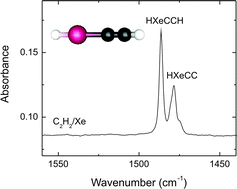Formation of noble-gas hydrides and decay of solvated protons revisited: diffusion-controlled reactions and hydrogen atom losses in solid noble gases
Abstract
UV photolysis and

a Laboratory of Physical Chemistry, P.O. Box 55, University of Helsinki, Finland
b Verkin Institute for Low Temperature Physics and Engineering, Kharkov, Ukraine
UV photolysis and

 Please wait while we load your content...
Something went wrong. Try again?
Please wait while we load your content...
Something went wrong. Try again?
H. Tanskanen, L. Khriachtchev, A. Lignell, M. Räsänen, S. Johansson, I. Khyzhniy and E. Savchenko, Phys. Chem. Chem. Phys., 2008, 10, 692 DOI: 10.1039/B713212C
To request permission to reproduce material from this article, please go to the Copyright Clearance Center request page.
If you are an author contributing to an RSC publication, you do not need to request permission provided correct acknowledgement is given.
If you are the author of this article, you do not need to request permission to reproduce figures and diagrams provided correct acknowledgement is given. If you want to reproduce the whole article in a third-party publication (excluding your thesis/dissertation for which permission is not required) please go to the Copyright Clearance Center request page.
Read more about how to correctly acknowledge RSC content.
 Fetching data from CrossRef.
Fetching data from CrossRef.
This may take some time to load.
Loading related content
